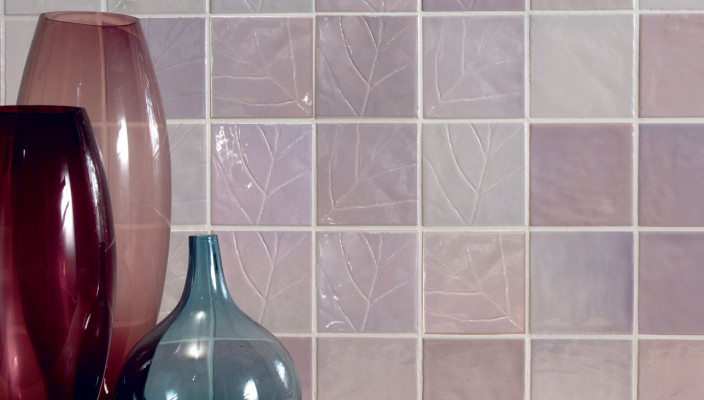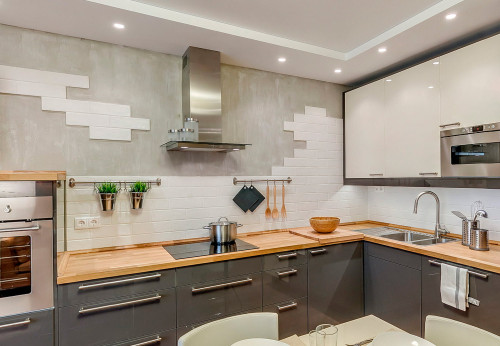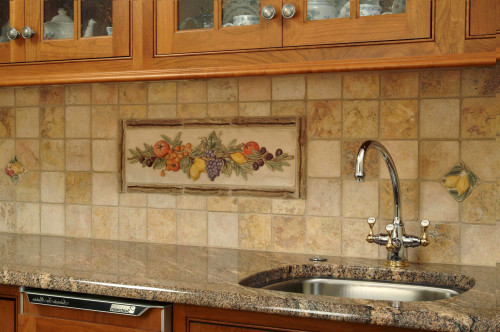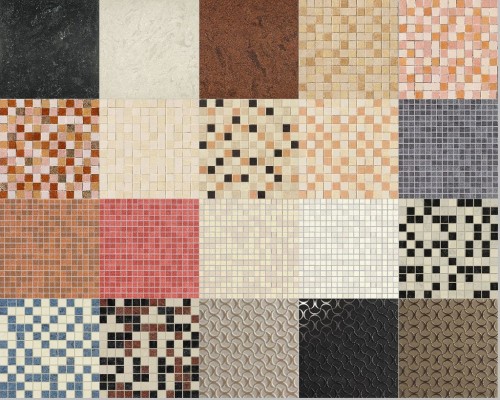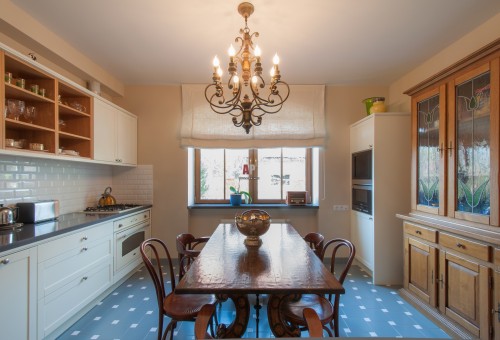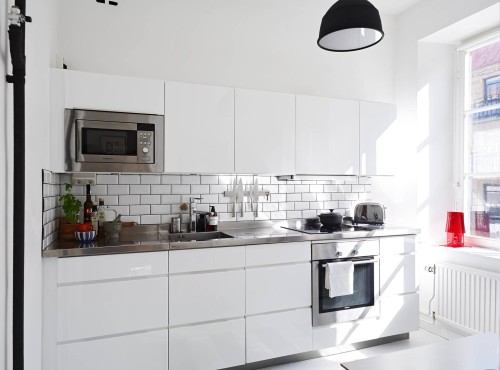Ceramics is a material that will never come out of fashion. It so much that decent competitors did not have a ceramic tile even today, when the leading corporations create really amazing materials, which previously could only dream. Ceramics is also a universal resource, which can be safely used in almost any rooms.
Content
Manufacturers of ceramic finishing materials are actually a huge range of products. Especially relevant today to pay attention to personal orders. Each host can contact a particular manufacturer to release just such a tile that matches a number of requirements. It may not only be about the dimensions of the material, but also about images that are easily applied to the karmic surface.
To date, the most common places for decoration of the walls with ceramic tiles remain kitchen and bathroom. These two spaces are ideal for the use of ceramics. In this article, we will consider the main features of the ceramic tile, and also analyze all stages of wall finishing with this material. You can safely say that even people without experience will be able to work in finishing works. All thanks to the practicality and many other positive parties to ceramic tiles.
Features of ceramic tile
As we said, ceramic tile is a permanent leader among finishing materials. Of course, in recent years, many new resources have appeared, allowing to make the surface of the walls are really unique, but there are no direct competitors in the ceramic material. Moreover, gradually the ceramic tile is improving, and above all it concerns the appearance of the material, since its characteristics have already been ideal for most conditions for the most conditions in which this resource is applied.
The versatility of ceramics simply amazes. Wall decoration tiles can be used in almost any rooms. For example, even in the bedroom the walls can be separated by this material, however, this solution is extremely rare for obvious reasons. Thus, it is better to consider in detail all the strengths and weaknesses of the ceramic tile. Running a little challenge can be noted that the disadvantages of this finishing resource also has, and in some cases they may have significantly greater weight than dozens of advantages.
Advantages and disadvantages of ceramic tiles
Let's start with the strengths of the ceramic resource:
- Wear resistance. The reliable coating of ceramic tiles is actually able to serve for many years. Even in the most severe conditions in which the room is located, the tile will delight its original appearance for many years. Of course, a certain care for the material is still recommended, however, the wear resistance of the ceramic tile is striking, and is particularly well this advantage over the background of many modern materials.
- Strength. People who have experience working with many finishing materials, perfectly know that only natural stone can compete with ceramic tiles in terms of strength. The remaining materials even closely do not correspond to the strength of ceramics. Hanging the tile is quite real only by blows with heavy objects, however, the practice shows that such emergency situations occur extremely rarely. Another popular finishing material for the walls - PVC panel - is damaged even from minimal effects. Thus, in terms of strength to ceramics, there is simply no equal, and this situation happens for long years.
- Water resistance. For most rooms, where ceramics are used, this characteristic is extremely important. As part of the bathroom, ceramics and is at all indispensable. In this article, we will consider the decoration of the ceramic tiles of the kitchen, and it is to this space that the material is revealed for most parameters. Under the action of moisture, the tile can be covered with fungus and other bacteria, but all this can be elementary cleaned. It should be borne in mind that today, among the materials, the ceramics is easiest to clean. In order to make the surface clean, it is enough to use a large water pressure.
- A huge range of products. Ceramic tile, despite its long existence, is the very basis that allows you to create new product options, both in terms of appearance and other characteristics. Most often, the owners pay attention to the style of the tile, and it is from this that it is repelled when the finishing material is selected. Also, the product range concerns and dimensional material. You can easily choose exactly the tile, which in the best way will fit into the available space. It can also be noted that, if necessary, ceramic tiles can be easily cut, while the material itself does not lose the most important properties. All of the above features that include the advantages of the range are not available for most similar materials.
- Tile does not ignite. Many materials made on the basis of plastic and some other resources, under the action of a source of ignition, immediately begin to burn, and actively. This is an extremely bad situation, as in any premises, even the most specific, there must be complete safety. Ceramic tile does not give in to ignition, and that is why this material is advisable to use in the kitchen and the like spaces. In addition, under the action of direct sunlight, the tile will not lose its saturated surface color, and in frosty weather, the material never cracks.
Consider also the main disadvantages of ceramic tiles:
- Low heat insulation. It is safe to say that in the room where the walls are lined with ceramic tiles, it will be badly kept warm in cool seasons. It is important to keep in mind that in the summer period this deficiency becomes an advantage, since in this room there will always be relatively cool. Low thermal insulation is often the disadvantage, due to which the owners refuse to ceramic tiles. With this situation, it is necessary to consider all sorts of insulation variants, up to laying mineral wool under the ceramic surface layer. If the tile is placed on the floor, then on such a surface it will not be very pleasant to walk with bare feet at any time, and you need to remember. At the same time, it is possible to install a warm floor system on the surface, and ceramics is warmly carried out in the best way. In the case of the walls, it is better not to take anything like that.
- The complexity of the facing. It should be borne in mind that the ceramic tile is a heavy material that is quite difficult to make surface cladding. At the same time, it is possible to lay the material only on the perfectly level reason, otherwise it will not be possible to avoid problems. It is worth keeping in mind that for facing the walls in the room, which has a large area, it is advisable to use the services of specialists. Unlike wallpaper, PVC panels, and other decorative materials, ceramic tiles is not an easy to use resource for finishing. Of course, there are a variety of conditions, in terms of which produce veneer surface, it may be just enough.
Separately, it can be noted that a shortage of ceramic products can be a disadvantage for many owners. However, in construction supermarkets and on wholesale bases, you can easily find low-cost Tile options. Yes, such products may not look too solid, but we are guaranteed to get a solid and reliable surface with many other advantages. Do not forget that now in fashion minimalism, so the simple tile often looks smart in any rooms.
Select tile
People who are first sent to acquire a tile to lick the walls later, are not always focused on the main issues related to the choice of material. Ultimately it turns out that the tile does not correspond to the basic requirements that dictated at the very beginning. Thus, consider the most important issues related to the characteristics of the tile:
- To begin with, if the tile is selected for the kitchen room, you need to pay attention to its thermal resistance. If the material does not have the required level of resistance to high temperatures, then cracks will begin to form cracks on the surface of the tile, to get rid of which will not work. Unfortunately, often such cracks make the appearance of the room extremely unattractive, so you will ultimately have to remove the tile from the walls and throw it away.
- Also negatively on the state of the tile affects various aggressive substances that fall onto its surface. This is a particularly dangerous situation when the material has increased porosity, and with such a slad, the tile begins to collapse, lose the most important properties and an attractive appearance.
- When choosing a tile, pay attention to the type of its surface. It is better to use a matte tile for the kitchen, which if it starts to doll, then the surface will not look too bad. Often, the hosts prefer the light glossy tile, which is clearly visible not only contamination, but also the usual fingerprints.
- You can safely combine different tile options. For example, for the kitchen it can be a white tile and green. The main thing is to provide a combination of selected colors with existing objects in the interior.
- And, of course, it is impossible to bypass the tile manufacturer's side. It is advisable to make a choice in favor of proven companies that have been producing tiles for many years. It is also not worth overpaying for a well-known brand, as it is often about it simply makes no sense.
There are also some other details to pay attention to. For example, if the room is too small, it is not worth using a dark tile, since the visually space will become too tiny. In addition, it is impossible to use a floor tile as wall cladding, as an option for vertical surfaces is much thinner and easier. Tile with a lot of weight on the wall sooner or later collapses.
Well, it is also necessary to understand that the main thing in the tile is the correctness of the geometric forms, since otherwise the material will not be combined with each other, and the process of laying the tile can turn into a real test.
The process of decoration walls of kitchen ceramic tiles
Preparatory activities
- First of all, it is necessary to prepare the foundation for the lining of the walls with tiles. To begin with, it will be necessary to clean the surface from dirt, dust and other contaminants that can be removed using a cloth or brush. Often on the surface of the wall there is too weak plaster, which is preferably deleted at the same stage.
- Immediately after that, a tool called the rule is useful. We apply it to the wall and refer all the irregularities that can be available. Accordingly, if "lumens" appear between the rule and the wall, it is necessary to react. Experts are recommended to produce wall alignment only if the walls of the wall make up more than 5 mm. If deviations are less than this value, then you can safely begin facing.
- As for the alignment of the wall, here it is necessary to note the integer 2 variants of the process. The first is in full alignment, and the second is in partial. In the first case, a complete replacement of the plastering layer occurs when using beacons. In addition, instead of applying plaster, it is possible to use plasterboard sheets that need to be additionally fixed to the base surface of the wall (since under the action of the weight of the tile plasterboard can be deformed). Partial wall alignment is often carried out with the help of tiled glue, which will be used to fit the ceramic material.
- Separately, it is worth noting that the surfaces from lime plasters must be strengthened. If you carry out the primer, any finishing materials will be better clicked with the surface. If we have a fuel surface, then the whole 2 layers of the primer will be required. The first is an emulsion diluted with water, and the second is an undivided primer mixture.
- In the event that the owners are aimed to bite the surface with a tile on top of the old material, then, first of all, it is worth analyzing the state of the old material. If the tile is in a normal state, and the surface itself is flat, it is enough just to thoroughly clean the wall, after which you can safely apply a new layer of tiles.
- If the facing is planned for plasterboard sheets, it is advisable to create a waterproofing layer.
Marking of walls
To date, the owners have the opportunity to mount the tile on the basis of the wall as they wish. It is about placing the tiles horizontally, vertically and even diagonally. The most important thing is a reliable fastening, as well as the external attractiveness of the walls.
The laying of the tile occurs from the bottom up, and it is from this information that you want to repel when markup. Often the multiplicity of the sizes of the tile does not correspond to the multiplicity of wall dimensions, therefore, it is highly likely to be cutting the material. Often the cropped tile is used for laying in the inner corners of the room.
Based on the above information, it is possible to make a small marking with the help of a conventional construction pencil. However, it must be remembered that many owners prefer to create gaps between the tiles, and for this case, the cross-lands were used. These small indents also need to be considered when marking.
Specialists also note that if it is not all the wall with the help of the tile, but only its part, then it is necessary to lay the material from top to bottom. The thing is that with this situation, the cut tiles will be only at the lower level (base row). The appearance of such a tiled insert will be very attractive.
Wall cladding process tiles
- First of all, you need to prepare a glue solution. To do this, you need to explore the information specified in the glue instructions. The application of glue on the wall surface occurs a smooth side of the spatula, after which the uniform distribution of the binder material is carried out using the toothed side of the tool.
- It must be remembered that glue dries very quickly, so it is necessary to apply glue to a small wall area - up to 1 square meter. Often a small layer of glue dries up to 30 minutes. If the glue is dried, but the tile has not been fixed, it will have to apply forces to remove this layer from the wall, then apply a new one.
- The larger the sizes of the tile, the larrhery should be the teeth of the spatula.
- Most of all attention should be paid to tile, which has some irregularities on its surface. This can be self-made material, or a mosaic that does not always correspond to some rigid geometric parameters. Thus, for reliable fastening of the material to the wall surface, it is necessary to apply glue to the tile itself. Most often, there are enough two thin layers of the binder material on the tile and the wall so that the facing is reliably held for long years.
- Laying the tiles begins below and continues vertically. Starting from the bottom level to the top of the wall 3-4 tiles are stacked, then we move left or right and carry out the same manipulations. Thus, the laying comes from the angle and evenly occurs to the opposite top corner of the wall.
- The most important thing after laying each unit of the tile to check the horizontal and verticality of the location of the material using the construction level. Any, even the most minor deviations that will definitely be available, should immediately correct. If the inaccuracy of the location is still manifest, then the previously created markup may not comply with the current situation.
- Of course, it is impossible to forget about the seams that experts are often used to create a fixed distance between units of cladding. Already after the finish process is completed, the cross can be simply removed from the surface.
- After laying the tile, it is necessary to press it a bit to the wall, so that the high-quality clutch with the surface occurred. For greater reliability, you can apply a rubber Cyanka, which tap the tile when the glue is not dry. If surplus glue appear around the tile, you need to immediately remove it with a conventional cloth. Unfortunately, the traces of dried glue later will be extremely difficult to remove.
- It is also worth remembering that in the room where the facing takes place is uniquely there are sockets, pipes or other communications, which must be adapted to adjust the tile. Accordingly, you need to use special ceramics cutters to cut circles or semicircles. It is necessary to make such manipulations carefully, since it is not recommended to damage the whole tile - it is extremely simple, and it is not recommended to use damaged material.
Filling seams between tiles
If crossings were used in the process to create seams between the tiles, then at the very end these crosses need to be removed, and then fill the seams with the corresponding grip.
For the preparation of grouts, a dry mass of the solution is kneaded with water in a small capacity. After carefully mixing, after 10 minutes, the grout becomes uniform, and it can be safely used to fill the seams. The filling of the seams occurs with the help of a rubber spatula, and excess material is expediently removed using a conventional wet rag.

